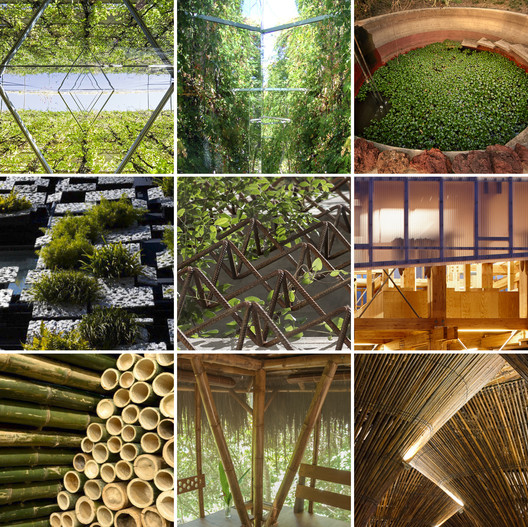
The dramatic improvement in recent decades in our understanding of sustainable design has shown that designing sustainably doesn't have to be a compromise—it can instead be a benefit. When done correctly, sustainable design results in higher-performing, healthier buildings which contribute to their inhabitants' physical and mental well-being.
The benefits of incorporating vegetation in façades and in roofs, as well as materials and construction systems that take energy use and pollution into account, demonstrate that sustainable design has the potential to create buildings that improve living conditions and respect the natural environment.
Below we have compiled 30 plans, sections and construction details of projects that stand out for their approach to sustainability.
Incorporation of vegetation: A layered system that incorporates the use of vegetation on roofs and facades—which can also incorporate other systems such as urban gardens or water recycling systems—provides significant economic, social and environmental benefits. These systems are particularly useful in improving sustainability in crowded urban areas.
01. AA House / IR arquitectura

02. Lacapelle-del-fraisse / Atelier du Rouget Simon Teyssou & associés

03. Tarrawarra Abbey / Baldasso Cortese Architects

04. GPL House / Estudio BLT

05. Casa Scout / BAAG

06. Silvina and Omar House / IR arquitectura

07. Edificio Consorcio Santiago / Enrique Browne + Borja Huidobro

08. Once Building / Adamo Faiden

09. Green Cast / Kengo Kuma & Associates

10. Pasaje Cabrer Collective Housing / AFRa

11. Eco Boulevard in Vallecas / Ecosistema Urbano

Use of local materials and the study of construction systems: The choice of material responds to both the availability of local resources and to the local climate, allowing the interior spaces to be adapted to the external climatic conditions. The use of local resources and the design of a construction system which responds to the natural characteristics of the place also gives the benefit of a lower cost with respect to transportation and maintenance.
12. House in the Woods / Parque Humano

13. Lienzo de Barro House / Chaquiñán
.jpg?1482849911)
14. Centro Holístico Punto Zero / Dio Sustentable

15. Museum & Biodiversity Research Center / Guinée et Potin Architects

16. Zenkonyu / Tadashi Saito + Atelier NAVE

17. 21st Century Vernacular House / Edra arquitectura km0

18. Bamboo Wing / Vo Trong Nghia

19. El Guadual Children Center / Daniel Joseph Feldman Mowerman + Iván Dario Quiñones Sanchez

20. Hostal and Capacitation Center / IR arquitectura
.jpg?1482850239)
21. Kontum Indochine Café / Vo Trong Nghia Architects

22. Temporary Pavillion at UNAM / México

23. Snow House / Emilio Marin, Nicolas Dorval-Bory, Juan Carlos Lopez

The study of bio-environmental design: When carrying out a project that aims to optimize building performance using only natural environmental factors, an understanding of the mechanics of those environmental factors is key. These buildings must take advantage of the natural energy of the sun and the wind, incorporating them into an architectural design.
24. Patagonia's Sustainable Social Housing / Aysén, Chile

25. Bioclimatic Dwelling in Tenerife / Ruiz Larrea y Asociados

26. World's First Prefabricated Carbon Positive House / ArchiBlox

27. Dixon Water Foundation Josey Pavilion / Lake|Flato Architects

28. Nest We Grow / College of Environmental Design UC Berkeley + Kengo Kuma & Associates

29. Casa Meztitla / EDAA

30. Quito Publishing House / Estudio A0




.jpg?1482849369)


.jpg?1482849395)

.jpg?1482849419)
.jpg?1482849427)
.jpg?1482849437)
.jpg?1482849445)












.jpg?1482849585)
.jpg?1482849592)
.jpg?1482849616)
.jpg?1482849624)
























.jpg?1482849904)







































































